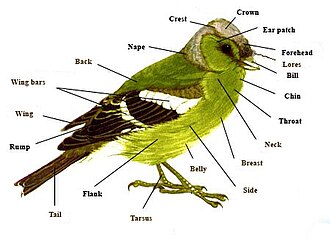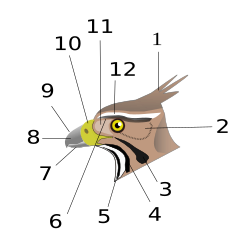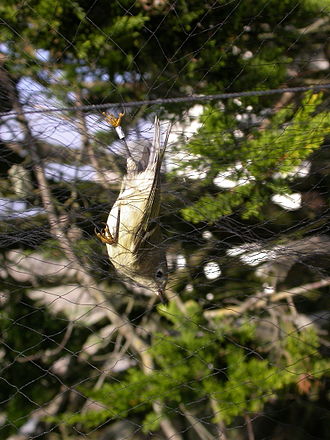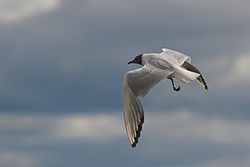Difference between revisions of "AY Honors/Birds - Advanced/Answer Key"
| Line 86: | Line 86: | ||
==11. Present lists of birds, showing the greatest number of species seen out of doors in: <br>a. One day (with at least six hours in the field) <br>b. One week <br>c. Your lifetime (all birds observed by you since you began birding to date) == | ==11. Present lists of birds, showing the greatest number of species seen out of doors in: <br>a. One day (with at least six hours in the field) <br>b. One week <br>c. Your lifetime (all birds observed by you since you began birding to date) == | ||
| − | ==12. | + | ==12. Make a list of ten species of wild birds that you personally have positively identified by sound out of doors, and describe or imitate these bird sounds as best you can. == |
| − | Listen to the bird calls found in the Field Guide | + | Listen to the bird calls found in the [[Field Guide/Birds|Field Guide]]. Then listen for them in the wild. |
==13. Lead a group in a bird observation walk or tell two Bible stories in which a bird was significant. == | ==13. Lead a group in a bird observation walk or tell two Bible stories in which a bird was significant. == | ||
Revision as of 03:53, 14 March 2008
Template:Honor header Template:AY Master
1. Have the Birds Honor.
2. Know the laws protecting birds in your state, province, or country.
3. Describe a bird accurately by using standard names for each part of its body.
4. Find answers to either a. OR b.
a. In what ways are the feet, legs, and beak of birds variously modified to adapt them to their environment?
b. On hummingbirds:
(1) What do hummingbirds eat in the wild and how often?
(2) Why aren't hummingbirds afraid of large mammals or birds?
(3) How do their wings move differently from other birds?
(4) How fast do they fly?
(5) How fast do the wings and heart beat?
(6) How is the tongue shaped?
5. Identify on a bird's wing the primaries, secondaries, coverts, axillars, and alulae.
- Primaries
- Secondaries
- Coverts
- Axillars
- Alulae
- The alulea (singular is alula) are small projections on the leading edge of the wing near the carpal joint (6). They are actually one of the bird's digits, and are typically covered with three to five small feathers, with the exact number depending on the species. Like the larger flight feathers found on the wing's trailing edge, these alula feathers are asymmetrical, with the shaft running closer to leading edge.
6. Describe the functions and purposes of bird banding, telling in particular how banding contributes to our knowledge about bird movements.
Bird banding (also known as bird ringing) is an aid to studying wild birds, by attaching a small individually numbered metal or plastic ring to their legs or wings, so that various aspects of the bird's life can be studied by the ability to re-find the same individual later. This can include migration, longevity, mortality, population studies, feeding behavior, and many other aspects.
Terminology and techniques
Those who ring birds are called "bird ringers". Organized banding efforts are called "ringing schemes" and the organizations that run them, "ringing authorities". Birds are "ringed" (rather than "rung"). When a ringed bird is found, and the ring number read and reported back to the ringer or ringing authority, this is termed a "ringing recovery" or "control".
Birds are either ringed at the nest, or after being trapped in fine mist nets, Heligoland traps, drag nets, cannon nets, duck decoys or similar.
A ring of suitable size is attached, and has on it a unique number, plus a contact address. The bird is often weighed and measured, and examined for parasites (which may then be removed) before release. The rings are very light-weight, and have no adverse effect on the birds. The individual birds can then be identified when they are re-trapped, or found dead.
The finder can contact the address on the ring, give the unique number, and be told the known history of the bird's movements.
The organizing body, by collating many such reports, can then determine patterns of bird movements for large populations.
The first organized schemes for bird ringing were started (in 1909) by Arthur Landsborough Thomson in Aberdeen and Harry Witherby in England, though smaller individual marking tests had began some years earlier in Denmark and Germany.
Similar schemes
Wing tags
In some surveys, involving larger birds such as eagles, brightly-colored plastic tags are attached to birds' wing feathers. Each has a letter or letters, and the combination of color and letters uniquely identifies the bird. These can then be read in the field, through binoculars, meaning that there is no need to re-trap the birds. Because the tags are attached to feathers, they drop off when the bird moults. Imping is the practice of replacing a bird's normal feather with a brightly-colored false feather. A patagial tag is a permanent tag held onto the wing by a rivet punched through the patagium.
Radio transmitters and satellite-tracking
Where detailed information is needed on an individuals' movements, scientists can fit tiny radio transmitters to birds. For small species the transmitter is carried as a 'backpack' fitted over the wing bases, and for larger species it may be attached to a tail feather or temporary leg band. Both types usually have a tiny (10cm) flexible aerial to improve signal reception. Two field receivers (reading distance and direction) are needed to establish the bird's position using triangulation. Transmitters may be recovered by recapturing the bird or designed to drop off. The technique is useful for tracing individuals during landscape-level movements particularly in dense vegetation (such as tropical forests) and for shy or difficult-to-spot species, because birds can be located from a distance without visual confirmation. The use of satellite transmitters for bird movements is currently restricted by transmitter size - to species larger than about 400g. They may be attached to migratory birds (geese and swans are popular subjects) or other species undergoing longer-distance flights. Individuals may be tracked by satellites for immense distances, for the lifetime of the transmitter battery. As with wing tags, the transmitters may be designed to drop off when the bird moults; or they may be recovered by recapturing the bird.
Field-readable rings
A field-readable is a ring or rings, usually made from plastic and brightly colored, which may also have conspicuous markings in the form of letters and/or numbers. They are used by biologists working in the field to identify individual birds without recapture and with a minimum of disturbance to their behavior. Rings large enough to carry numbers are usually restricted to larger birds, although if necessary small extensions to the rings (leg flags) bearing the identification code allow their use on slightly smaller species. For small species (e.g. most passerines), individuals can be identified by using a combination of small rings of different colors, which are read in a specific order. Most color-marks of this type are considered temporary (the rings degrade, fade and may be lost or removed by the birds) and individuals are usually also fitted with a permanent metal ring.
Other markers
Head and neck markers are very visible, and may be used in species where the legs are not normally visible (such as ducks and geese). Nasal discs and nasal saddles can be attached to the culmen with a pin looped through the nostrils in birds with perforate nostrils. They should not be used if they obstruct breathing. They should not be used on birds that live in icy climates, as accumulation of ice on a nasal saddle can plug the nostrils. Neck collars made of expandable, non-heat-conducting plastic are very useful for larger birds such as geese.
Some results
An Arctic Tern ringed as a chick not yet able to fly, on the Farne Islands off the Northumberland coast in eastern Britain in summer 1982, reached Melbourne, Australia in October 1982, a sea journey of over 22,000 km (14,000 miles) in just three months from fledging.
A Manx Shearwater ringed as an adult (at least 5 years old), breeding on Copeland Island, Northern Ireland, is currently (2003/2004) the oldest known wild bird in the world: ringed in July 1953, it was retrapped in July 2003, at least 55 years old. Other ringing recoveries have shown that Manx Shearwaters migrate over 10,000 km to waters off southern Brazil and Argentina in winter, so this bird has covered a minimum of 1,000,000 km on migration alone (not counting day-to-day fishing trips). Another bird nearly as old, breeding on Bardsey Island off Wales was calculated by ornithologist Chris Mead to have flown over 8 million km (5 million miles) during its life (and this bird was still alive in 2003, having outlived Chris Mead).
7. Name the main migratory bird flyways used by birds in your continent.
8. Give the migration routes and terminal destinations for ten different migratory bird species.
9. Describe at least three different ways that birds are able to orient themselves in their movements across the globe.
10. Make a list of 60 species of wild birds, including birds from at least ten different families, that you personally have observed and positively identified by sight out of doors. For each species on this list note the following:
a. Name
b. Date observed
c. Place observed
d. Habitat (i.e., field, woods, river, lake, etc.)
e. Status where observed (permanent resident, winter resident, summer resident, migrant, vagrant)
11. Present lists of birds, showing the greatest number of species seen out of doors in:
a. One day (with at least six hours in the field)
b. One week
c. Your lifetime (all birds observed by you since you began birding to date)
12. Make a list of ten species of wild birds that you personally have positively identified by sound out of doors, and describe or imitate these bird sounds as best you can.
Listen to the bird calls found in the Field Guide. Then listen for them in the wild.
13. Lead a group in a bird observation walk or tell two Bible stories in which a bird was significant.
You will learn where the best places to see birds are as you go out birding yourself. If possible, take a group to one of those places. You can combine this trip with one of another purpose (such as a hike).
Bible stories that feature a bird as a significant part include, Noah sending out the dove, and Elijah being fed by ravens. In the Sermon on the Mount Jesus asks us to consider the birds of the air (they neither sow nor reap). The baptism of Jesus and Pentecost also feature doves.







